What does the update statement in mysql return?
The return result of the update statement in mysql: 1. When there is no "useAffectedRows=true" parameter in the database URL, the number of matching rows is returned; 2. When there is the "useAffectedRows=true" parameter in the database URL , returns the number of affected rows.

The operating environment of this tutorial: windows10 system, mysql8.0.22 version, Dell G3 computer.
What does the update statement in mysql return?
What is the number of matching rows that the result of the update statement returns? Or does it affect the number of rows?
Let’s talk about the results first: If the url of the database is:
jdbc:mysql://gitlab.fzghjx.com:3306/cron
, then the returned result is number of matching rows (Rows matched).
If it is:
jdbc:mysql://gitlab.fzghjx.com:3306/cron?useAffectedRows=true
, the number of affected rows (Changed) is returned.
To sum up:
If there is no useAffectedRows=true parameter in the url, the number of matching rows will be returned. If so, the number of affected rows is returned.
How to make its return value be the number of affected (changed) records?
Just add useAffectedRows=true to the mysql data connection url parameter
jdbc.url=jdbc:mysql://localhost:3306/ssm?useAffectedRows=true
Expand knowledge:
Guess
If you operate the update statement of mysql through cmd, the screen display is actually like this:

When I think about this problem, first There are two answers to the response. 1. Make a judgment in the return result of the mysql server. If this is set to true, the value of Rows matched is returned. If it is false, the value of Changed is returned. 2. Select this value when returning to the query statement.
Confirmation
Let’s use a diagram to illustrate the entire process of creating a connection:
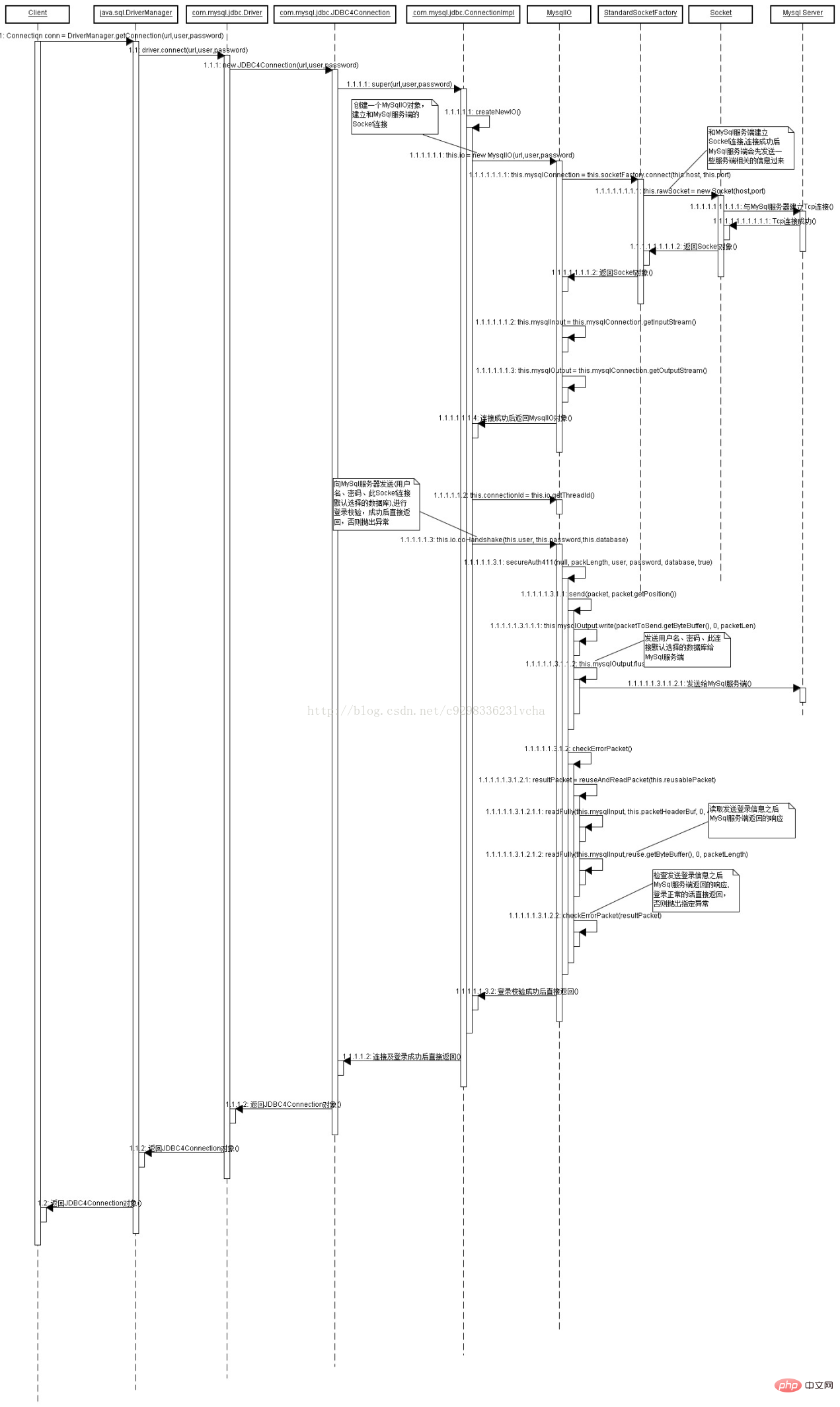
(Picture taken from: https://blog.csdn.net/c929833623lvcha/article/details/44517245)
After I studied for a while, I found that these two ideas All wrong. Specifically:
I wrote a simple jdbc query:
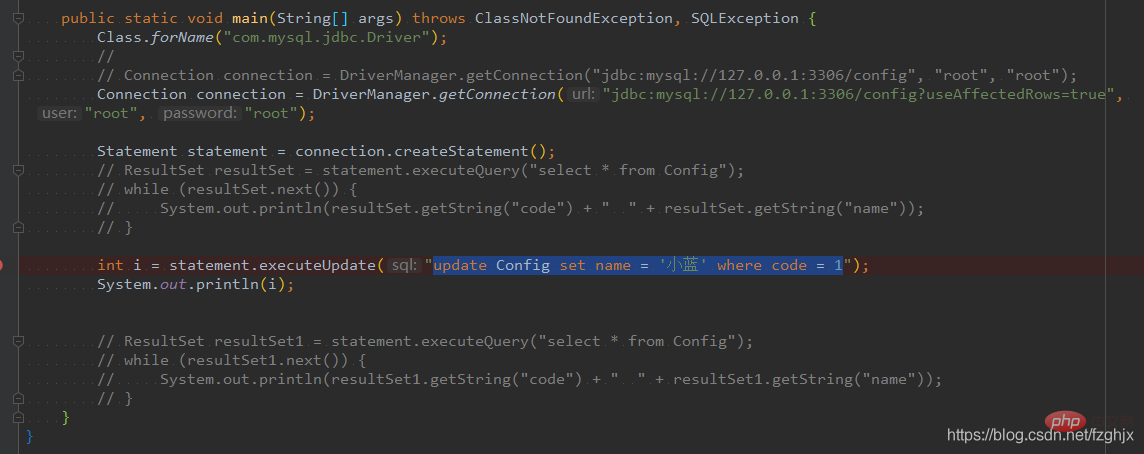
1, establish Connection
According to the source code and tracking, when mysql establishes a connection, the parameter useAffectedRows=true will be set as the connection attribute.
Follow down in
Connection connection = DriverManager.getConnection("jdbc:mysql://gitlab.fzghjx.com:3306/cron?useAffectedRows=true", "root", "root");:
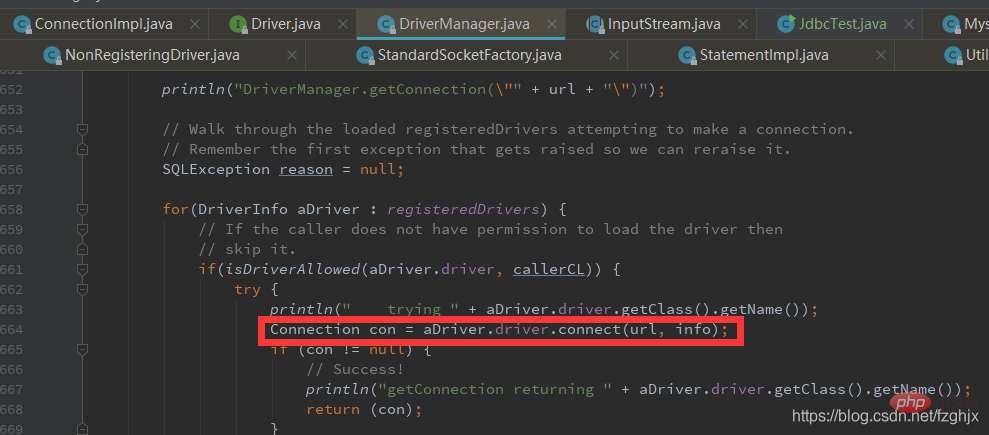
Continue: The connect method is: java.sql.Driver#connect, and the implementation is: com.mysql.jdbc.NonRegisteringDriver#connect
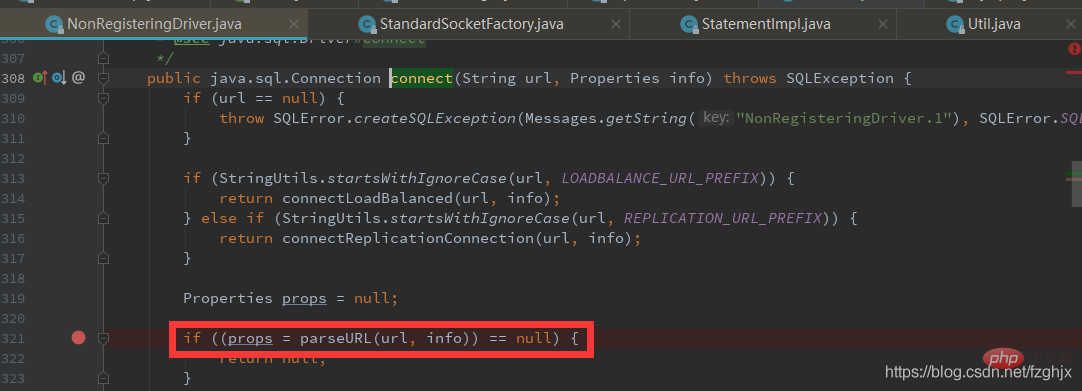
 ##Here is a reflection, args is
##Here is a reflection, args is
The constructor of JDBC is used:
 #The constructor of JDBC is:
#The constructor of JDBC is:
public JDBC4Connection(String hostToConnectTo, int portToConnectTo, Properties info, String databaseToConnectTo, String url) throws SQLException {
super(hostToConnectTo, portToConnectTo, info, databaseToConnectTo, url);
}Look up, it is the constructor of ConnectionImp:
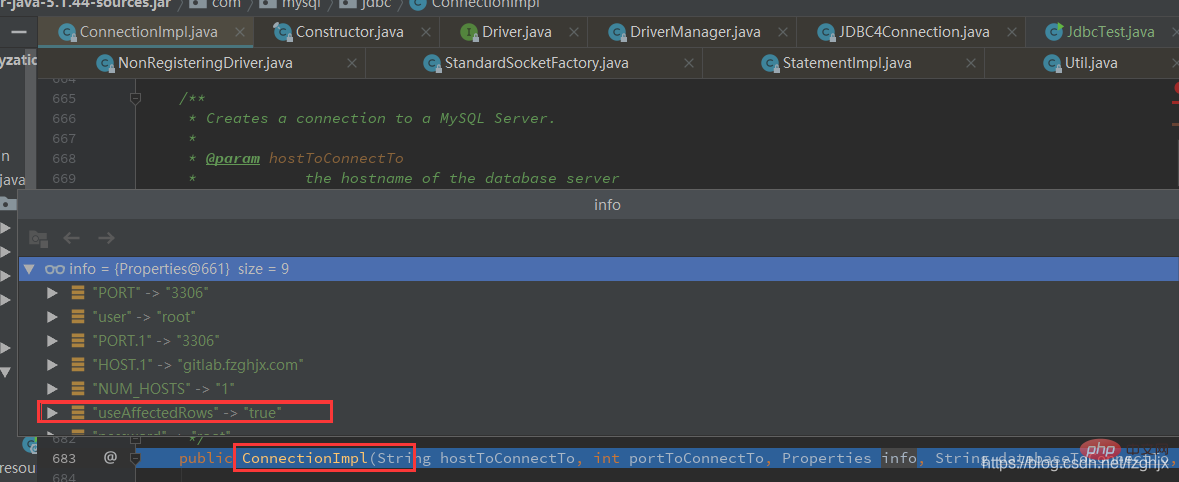 (By the way: The isolation level of the transaction is set to 2 here, and the read is committed)
(By the way: The isolation level of the transaction is set to 2 here, and the read is committed)
 In In this constructor, the value of useAffectedRows is initialized into the connection:
In In this constructor, the value of useAffectedRows is initialized into the connection:
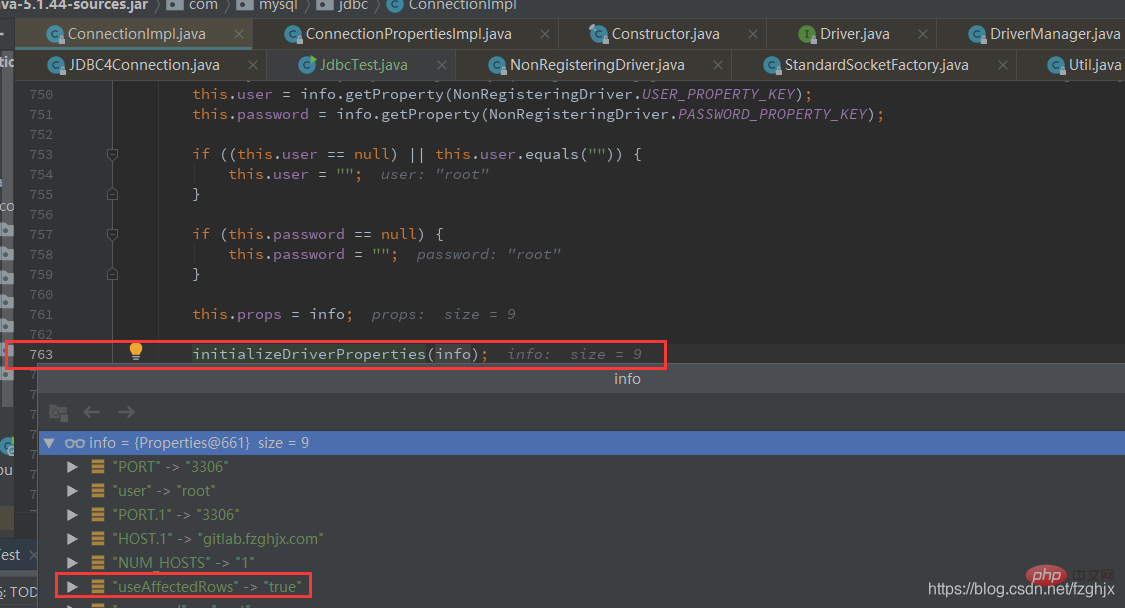 There are 206 properties to be set, useAffectedRows is ranked 190th (different mysql-connect -java version, location is different).
There are 206 properties to be set, useAffectedRows is ranked 190th (different mysql-connect -java version, location is different).
After the settings are completed:
##2, create MysqlIO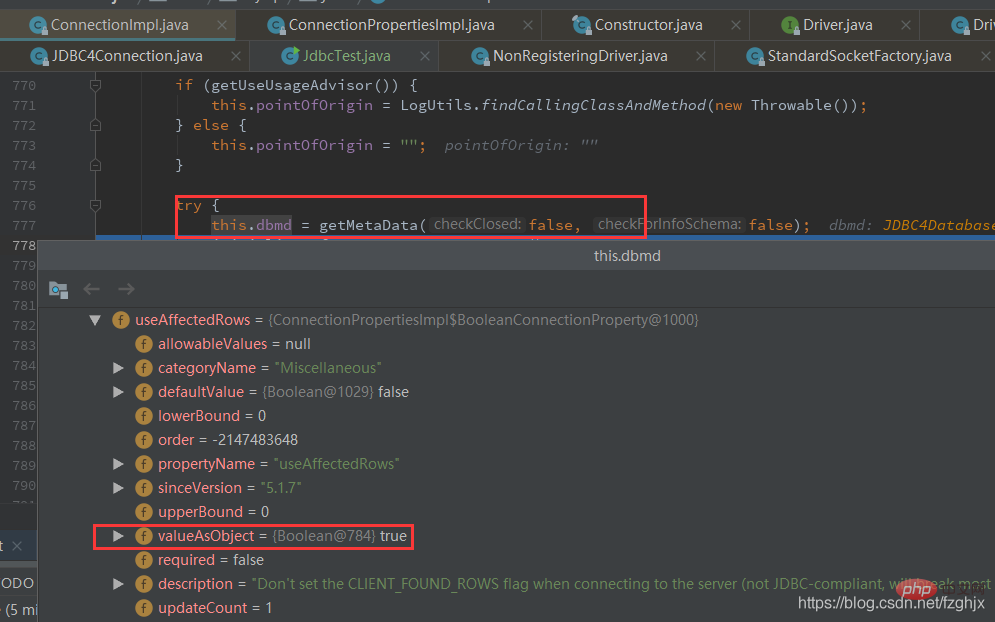

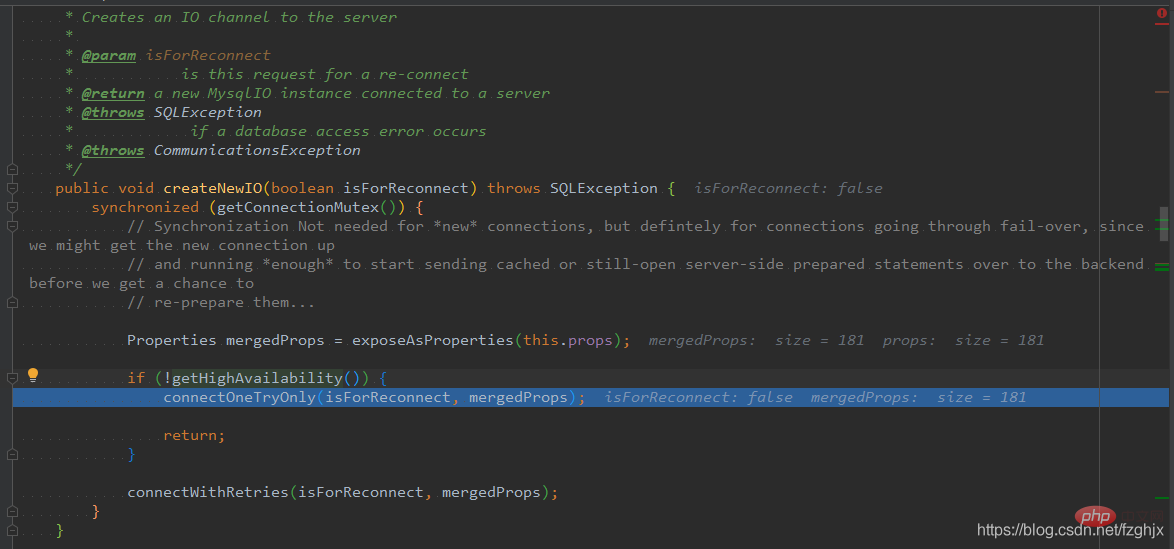
There is a "high availability" option. If so, a retry IO link will be created. Otherwise, create an IO link that is tried only once, and will not be retried if it fails. This option is also enabled in the URL by setting: autoReconnect=true.
3, handshake connection with msyql server
The connection IO process is actually to create a MysqlIO and then start the handshake:
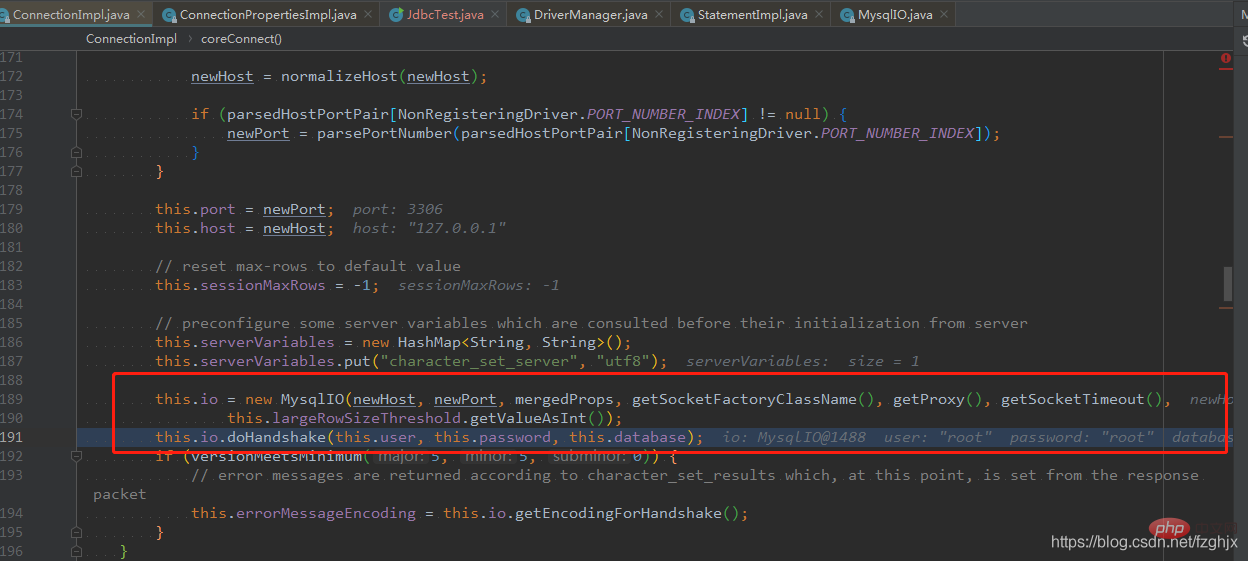
The key points Already: In the doHandshake method, the useAffectedRows option is set: (com.mysql.jdbc.MysqlIO#doHandshake)
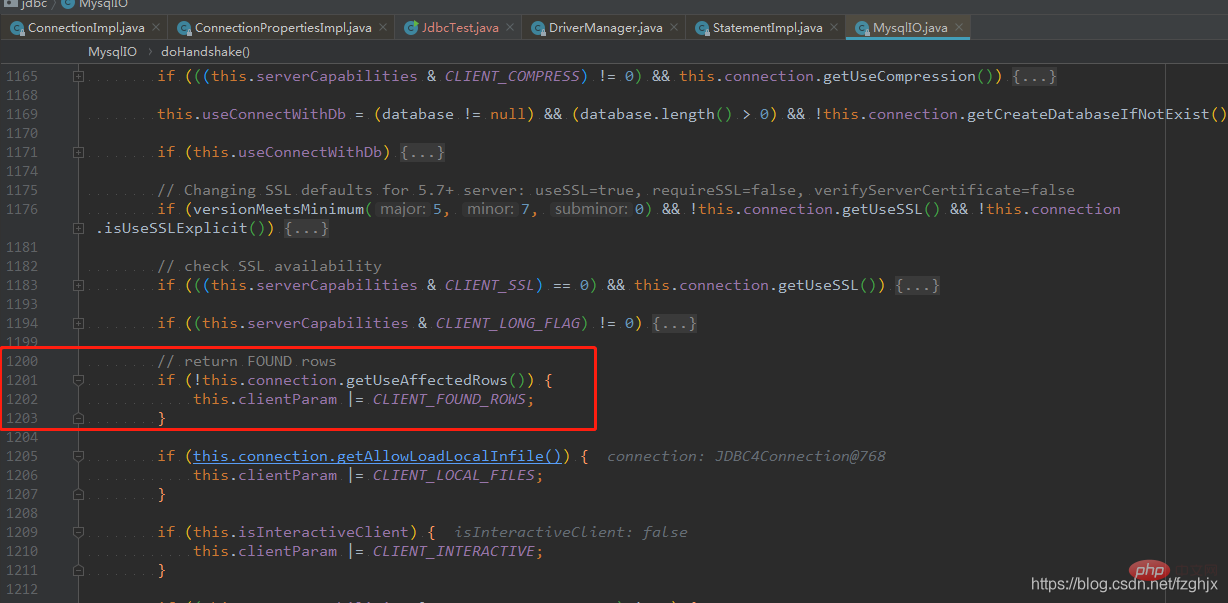

or operations. If useAffectsRows, no or operations will be performed.
After setting, send it to the mysql server through the mysqlOutput socket:
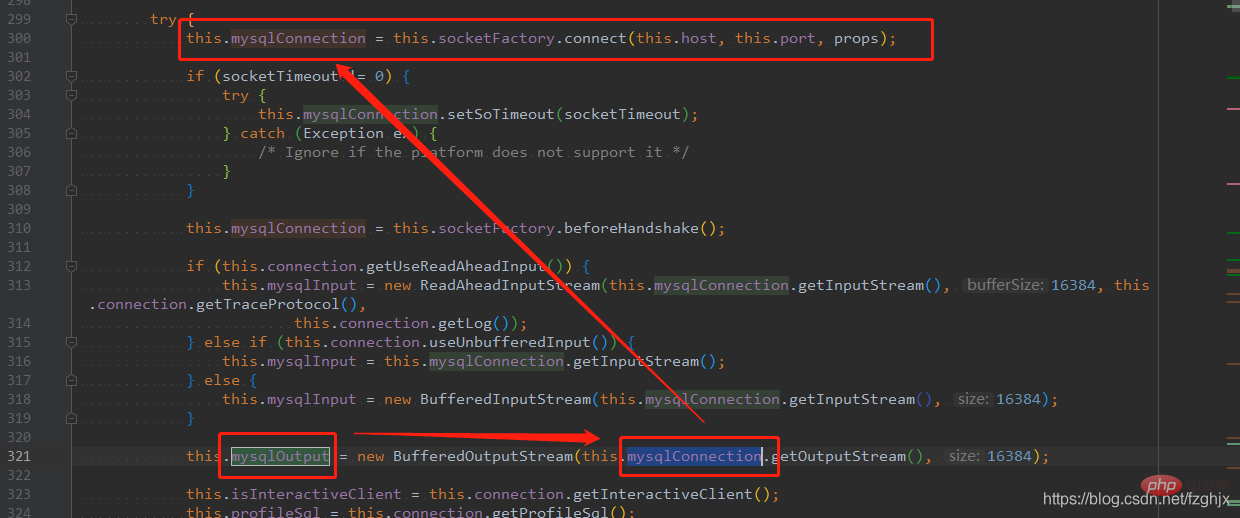
useAffectedRows=true:
Send request To mysql server:

Response from mysql server:
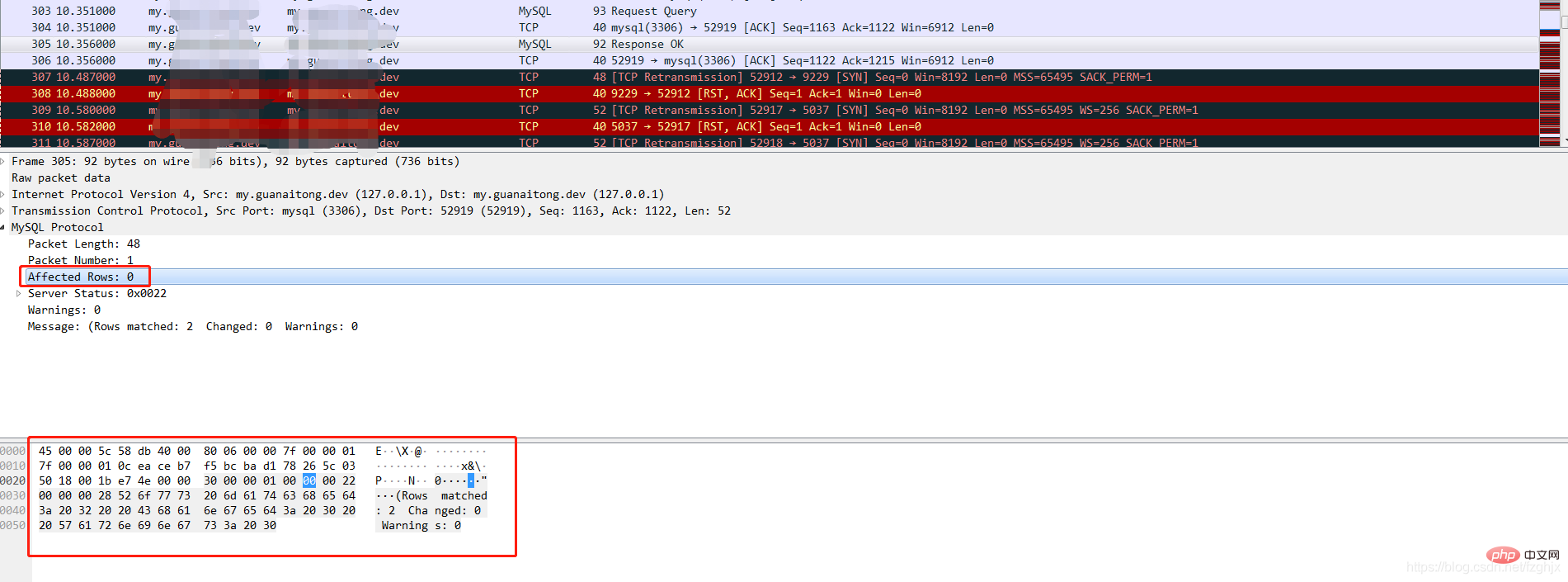
Send a request to the mysql server:
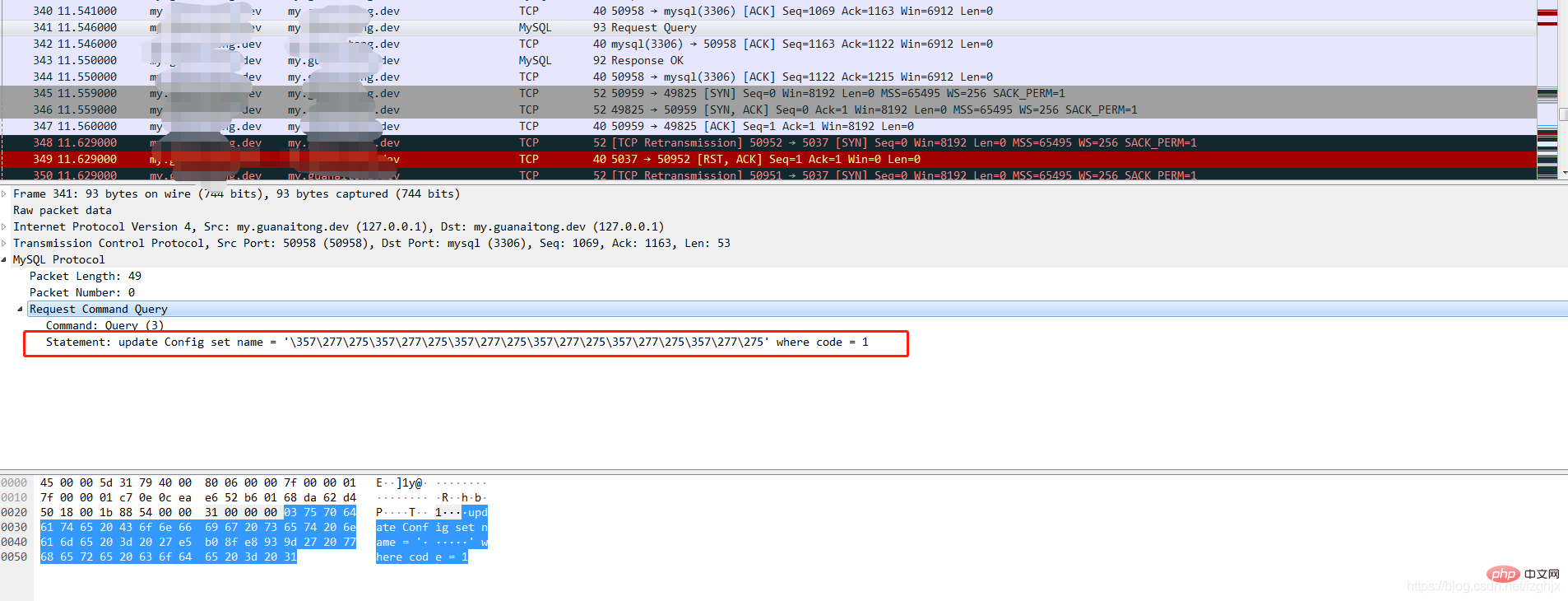 ##Mysql server’s response:
##Mysql server’s response:
As can be seen from the above message, when 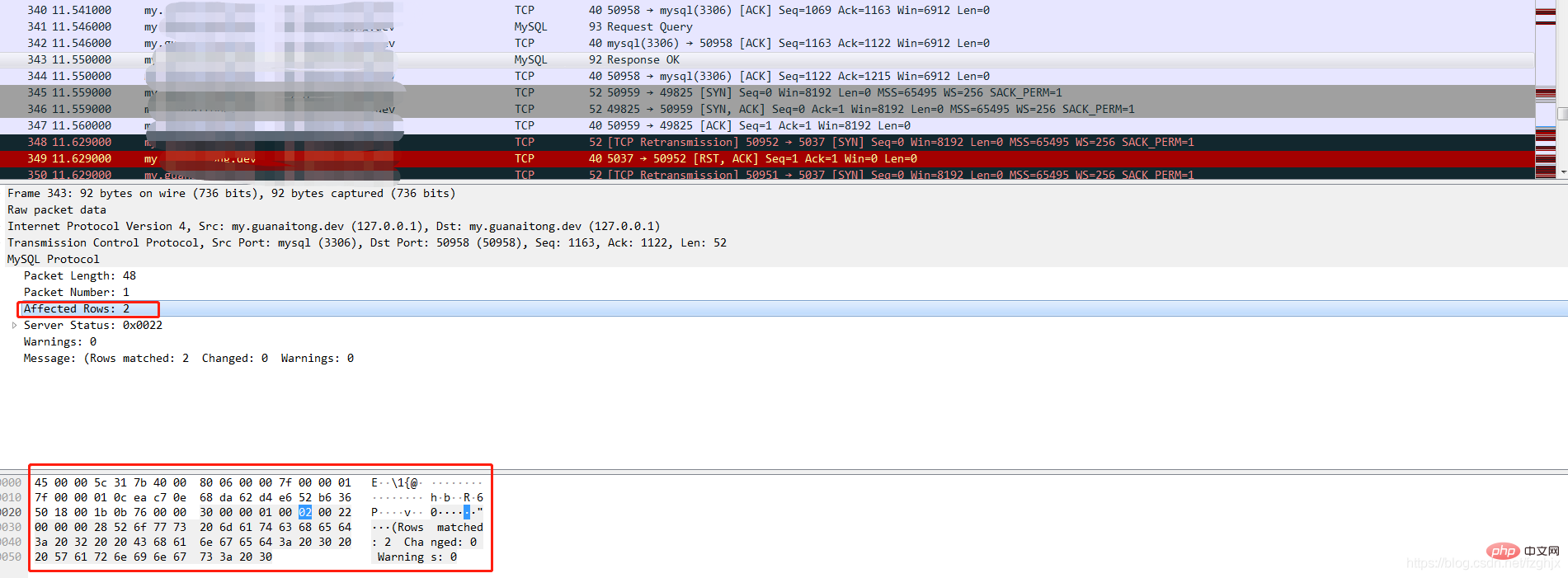 useAffectedRows is true and false, the return value of the msyql server is different
useAffectedRows is true and false, the return value of the msyql server is different
Recommended learning: mysql video tutorial
The above is the detailed content of What does the update statement in mysql return?. For more information, please follow other related articles on the PHP Chinese website!

Hot AI Tools

Undresser.AI Undress
AI-powered app for creating realistic nude photos

AI Clothes Remover
Online AI tool for removing clothes from photos.

Undress AI Tool
Undress images for free

Clothoff.io
AI clothes remover

AI Hentai Generator
Generate AI Hentai for free.

Hot Article

Hot Tools

Notepad++7.3.1
Easy-to-use and free code editor

SublimeText3 Chinese version
Chinese version, very easy to use

Zend Studio 13.0.1
Powerful PHP integrated development environment

Dreamweaver CS6
Visual web development tools

SublimeText3 Mac version
God-level code editing software (SublimeText3)

Hot Topics
 PHP's big data structure processing skills
May 08, 2024 am 10:24 AM
PHP's big data structure processing skills
May 08, 2024 am 10:24 AM
Big data structure processing skills: Chunking: Break down the data set and process it in chunks to reduce memory consumption. Generator: Generate data items one by one without loading the entire data set, suitable for unlimited data sets. Streaming: Read files or query results line by line, suitable for large files or remote data. External storage: For very large data sets, store the data in a database or NoSQL.
 How to use MySQL backup and restore in PHP?
Jun 03, 2024 pm 12:19 PM
How to use MySQL backup and restore in PHP?
Jun 03, 2024 pm 12:19 PM
Backing up and restoring a MySQL database in PHP can be achieved by following these steps: Back up the database: Use the mysqldump command to dump the database into a SQL file. Restore database: Use the mysql command to restore the database from SQL files.
 How to optimize MySQL query performance in PHP?
Jun 03, 2024 pm 08:11 PM
How to optimize MySQL query performance in PHP?
Jun 03, 2024 pm 08:11 PM
MySQL query performance can be optimized by building indexes that reduce lookup time from linear complexity to logarithmic complexity. Use PreparedStatements to prevent SQL injection and improve query performance. Limit query results and reduce the amount of data processed by the server. Optimize join queries, including using appropriate join types, creating indexes, and considering using subqueries. Analyze queries to identify bottlenecks; use caching to reduce database load; optimize PHP code to minimize overhead.
 How to insert data into a MySQL table using PHP?
Jun 02, 2024 pm 02:26 PM
How to insert data into a MySQL table using PHP?
Jun 02, 2024 pm 02:26 PM
How to insert data into MySQL table? Connect to the database: Use mysqli to establish a connection to the database. Prepare the SQL query: Write an INSERT statement to specify the columns and values to be inserted. Execute query: Use the query() method to execute the insertion query. If successful, a confirmation message will be output.
 How to create a MySQL table using PHP?
Jun 04, 2024 pm 01:57 PM
How to create a MySQL table using PHP?
Jun 04, 2024 pm 01:57 PM
Creating a MySQL table using PHP requires the following steps: Connect to the database. Create the database if it does not exist. Select a database. Create table. Execute the query. Close the connection.
 How to use MySQL stored procedures in PHP?
Jun 02, 2024 pm 02:13 PM
How to use MySQL stored procedures in PHP?
Jun 02, 2024 pm 02:13 PM
To use MySQL stored procedures in PHP: Use PDO or the MySQLi extension to connect to a MySQL database. Prepare the statement to call the stored procedure. Execute the stored procedure. Process the result set (if the stored procedure returns results). Close the database connection.
 How to fix mysql_native_password not loaded errors on MySQL 8.4
Dec 09, 2024 am 11:42 AM
How to fix mysql_native_password not loaded errors on MySQL 8.4
Dec 09, 2024 am 11:42 AM
One of the major changes introduced in MySQL 8.4 (the latest LTS release as of 2024) is that the "MySQL Native Password" plugin is no longer enabled by default. Further, MySQL 9.0 removes this plugin completely. This change affects PHP and other app
 The difference between oracle database and mysql
May 10, 2024 am 01:54 AM
The difference between oracle database and mysql
May 10, 2024 am 01:54 AM
Oracle database and MySQL are both databases based on the relational model, but Oracle is superior in terms of compatibility, scalability, data types and security; while MySQL focuses on speed and flexibility and is more suitable for small to medium-sized data sets. . ① Oracle provides a wide range of data types, ② provides advanced security features, ③ is suitable for enterprise-level applications; ① MySQL supports NoSQL data types, ② has fewer security measures, and ③ is suitable for small to medium-sized applications.






